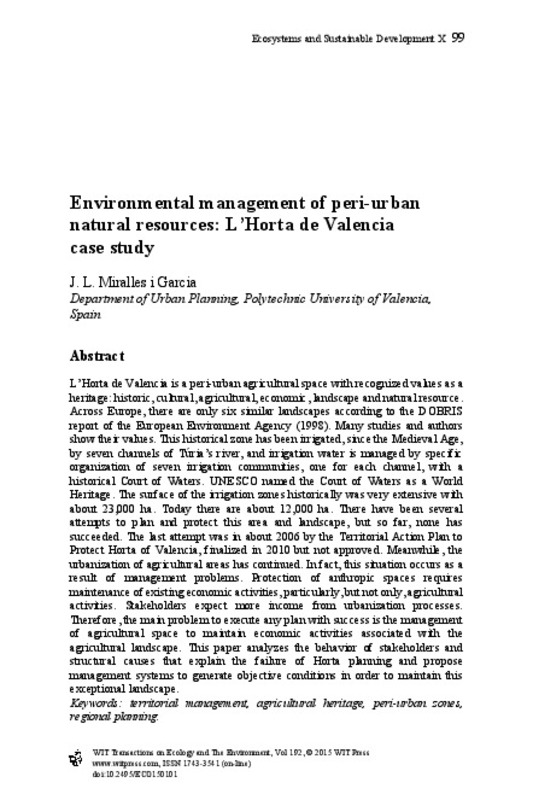JavaScript is disabled for your browser. Some features of this site may not work without it.
Buscar en RiuNet
Listar
Mi cuenta
Estadísticas
Ayuda RiuNet
Admin. UPV
Environmental management of peri-urban natural resources. L Horta de Valencia case study
Mostrar el registro sencillo del ítem
Ficheros en el ítem
| dc.contributor.author | Miralles García, José Luis
|
es_ES |
| dc.date.accessioned | 2015-11-16T16:51:46Z | |
| dc.date.available | 2015-11-16T16:51:46Z | |
| dc.date.issued | 2015 | |
| dc.identifier.issn | 1743-3541 | |
| dc.identifier.uri | http://hdl.handle.net/10251/57561 | |
| dc.description.abstract | L Horta de Valencia is a peri-urban agricultural space with recognized values as a heritage: historic, cultural, agricultural, economic, landscape and natural resource. Across Europe, there are only six similar landscapes according DOBRIS report of European Environment Agency (1998). Many studies and authors show their values. This historical zone is irrigated from Medieval Age by seven channels of Túria s river, and irrigation water is managed by specific organization of seven Irrigation Community, one for each channel, with a historical Court of Waters. UNESCO named the Court of Waters as a World Heritage. The surface of historical irrigation zones was very extensive with about 23.000 has. Today there are about 12.000 ha. There have been several attempts to plan and protect this area and landscape, but so far, none has succeeded. Last attempt was in about 2006 by Territorial Action Plan to Protect Horta of Valencia, finalized in 2010 but not approved. Meanwhile, urbanization of agricultural areas have continued. In fact, this situation occurs a result of management problems. Protection of anthropic spaces requires maintenance of existing economic activities, particularly agricultural activities but not only. Stakeholders expect more incomes by urbanization processes. Therefore, the main problem to execute with success any plan is the management agricultural space to maintain economic activities associates to agricultural landscape. This paper analyze the behavior of stakeholders and structural causes that explain failure of Horta planning and propose management systems to generate objective conditions in order to maintain this exceptional landscape | es_ES |
| dc.language | Inglés | es_ES |
| dc.relation.ispartof | WIT Transactions on Ecology and the Environment | es_ES |
| dc.rights | Reserva de todos los derechos | es_ES |
| dc.subject | Territorial management | es_ES |
| dc.subject | Agricultural heritage | es_ES |
| dc.subject | Per-urban zones | es_ES |
| dc.subject | Regional planning | es_ES |
| dc.subject.classification | URBANISTICA Y ORDENACION DEL TERRITORIO | es_ES |
| dc.title | Environmental management of peri-urban natural resources. L Horta de Valencia case study | es_ES |
| dc.type | Artículo | es_ES |
| dc.identifier.doi | 10.2495/ECO150101 | |
| dc.rights.accessRights | Abierto | es_ES |
| dc.contributor.affiliation | Universitat Politècnica de València. Departamento de Urbanismo - Departament d'Urbanisme | es_ES |
| dc.description.bibliographicCitation | Miralles García, JL. (2015). Environmental management of peri-urban natural resources. L Horta de Valencia case study. WIT Transactions on Ecology and the Environment. 192(WITPress):99-110. doi:10.2495/ECO150101 | es_ES |
| dc.description.accrualMethod | S | es_ES |
| dc.relation.publisherversion | http://dx.doi.org/10.2495/ECO150101 | es_ES |
| dc.description.upvformatpinicio | 99 | es_ES |
| dc.description.upvformatpfin | 110 | es_ES |
| dc.type.version | info:eu-repo/semantics/publishedVersion | es_ES |
| dc.description.volume | 192 | es_ES |
| dc.description.issue | WITPress | es_ES |
| dc.relation.senia | 292396 | es_ES |








